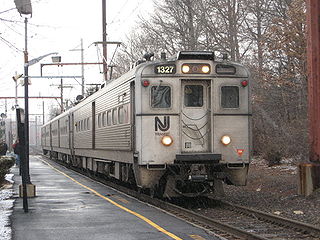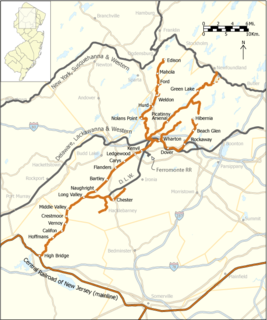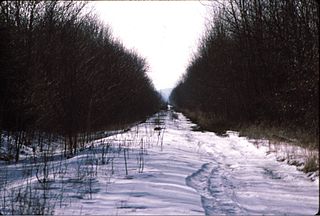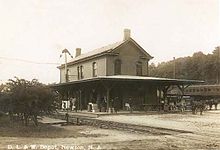
Sussex County is the northernmost county in the State of New Jersey. Its county seat is Newton. It is part of the New York metropolitan area and is part of New Jersey's Skylands Region. As of the 2020 U.S. census, the county's population was enumerated at 144,221, making it the 17th-most populous of the state's 21 counties, and representing a decrease of 5,044 (3.4%) from the 149,265 counted at the 2010 U.S. census, in turn an increase of 5,099 (3.5%) over the 144,166 persons at the 2000 census. Based on 2010 census data, Vernon Township was the county's largest in both population and area, with a population of 23,943 and covering an area of 70.59 square miles (182.8 km2).

Byram Township is a township in Sussex County, New Jersey, United States. As of the 2010 United States Census, the township's population was 8,350, reflecting an increase of 96 (+1.2%) from the 8,254 counted in the 2000 Census, which had in turn increased by 206 (+2.6%) from the 8,048 counted in the 1990 Census. The municipality is known as the "Township of Lakes", as there are roughly two dozen lakes and ponds within its borders.

The Delaware, Lackawanna and Western Railroad was a U.S. Class 1 railroad that connected Buffalo, New York, and Hoboken, New Jersey, a distance of 395 miles (636 km). Incorporated in Pennsylvania in 1853 primarily for the purpose of providing a connection between the anthracite coal fields of Pennsylvania's Coal Region and the large markets for coal in New York City. The railroad gradually expanded both East and West, eventually linking Buffalo with New York City.

The Gladstone Branch is a commuter rail line operated by NJ Transit from Gladstone station, in the U.S. state of New Jersey, to either Hoboken Terminal or New York Penn Station. It is one of two branches of the Morris & Essex Lines.
The Dover and Rockaway Railroad was a section of railroad track completed in 1881 connecting Dover, NJ and Rockaway, New Jersey. It formed an important link in the developing U.S. railroad system, connecting major trunks to the New York harbor for freight and provided passenger service to central and southern New Jersey.

The Lehigh and Hudson River Railway (L&HR) was the smallest of the six railroads that were merged into Conrail in 1976. It was a bridge line running northeast–southwest across northwestern New Jersey, connecting the line to the Poughkeepsie Bridge at Maybrook, New York with Easton, Pennsylvania, where it interchanged with various other companies.
The Morris and Essex Railroad was a railroad across northern New Jersey, later part of the main line of the Delaware, Lackawanna and Western Railroad.

The Lackawanna Cut-Off was a rail line built by the Delaware, Lackawanna & Western Railroad (DL&W). Constructed from 1908 to 1911, the line was part of a 396-mile (637 km) main line between Hoboken, New Jersey, and Buffalo, New York. It ran west for 28.6 miles (46.0 km) from Port Morris Junction in Port Morris, New Jersey near the south end of Lake Hopatcong about 45 miles (72 km) west-northwest of New York City to Slateford Junction in Slateford, Pennsylvania near the Delaware Water Gap.

The High Bridge Branch was a branch line of the Central Railroad of New Jersey (CNJ) that started in High Bridge, New Jersey at a connection with the CNJ main line and continued north to iron-ore mines in Morris County. The High Bridge Branch line followed the South Branch of the Raritan River for much of its duration.

Lake Hopatcong is a commuter railroad station for New Jersey Transit. The station, located in the community of Landing in Roxbury Township, Morris County, New Jersey, United States, serves trains for the Montclair-Boonton Line and Morristown Line at peak hours and on holiday weekends. Service from Lake Hopatcong provides to/from Hackettstown to New York Penn Station and Hoboken Terminal. The stop is located on the tracks below Landing Road next to the eponymous Lake Hopatcong. The station consists of one active and one abandoned side platform, along with a shelter on the active platform. There is no accessibility for handicapped persons under the Americans with Disabilities Act of 1990.

Netcong is an NJ Transit station in Netcong, in Morris County, New Jersey, United States. Located on Route 46 at Main Street in downtown Netcong, the small, 1-low level side platform station service passengers for the Morristown Line and the Montclair-Boonton Line. These lines provide service to Hoboken or to New York City via Midtown Direct on the Morristown Line at Dover station and Montclair-Boonton at Montclair State University station. Midtown Direct service can also be transferred at Newark Broad Street station in Newark. There is one track and one platform on the north side, adjacent to the station. NJ Transit maintains a substantial train servicing yard east of the Netcong station at Port Morris in Roxbury Township. Port Morris Yard is proposed to return as the junction of the Montclair-Boonton and Morristown lines for the Lackawanna Cut-Off line to Scranton. Transfers would be provided at Lake Hopatcong station in Landing.

Mount Olive is a NJ Transit station in Mount Olive, New Jersey, located in the International Trade Center. The station, located on the side of Waterloo Village Road, services trains for both the Montclair-Boonton Line and the Morristown Line along trackage owned by Norfolk Southern. The line is not electrified from Hackettstown to Dover, where passengers can transfer to an electric Morristown Line train via Summit or a diesel Montclair-Boonton train via Wayne and Montclair. Trains along both lines head to Hoboken Terminal in Hoboken, New Jersey or New York Penn Station at 34th Street in New York City, although Montclair-Boonton trains require a transfer at Montclair State University or Newark Broad Street for electrified service to New York.

Hackettstown is a New Jersey Transit station in Hackettstown, New Jersey. The station is located at the intersection of Valentine Street and Beatty Street and is the western terminus of the Morristown Line and the Montclair-Boonton Line, which both provide service to Hoboken Terminal or to Pennsylvania Station in Midtown Manhattan via Midtown Direct. Hackettstown station is the only active New Jersey Transit station in Warren County. The line from Hackettstown – Dover is diesel powered, requiring a transfer at Dover, Montclair State University or Newark Broad Street to an electrified train to New York Penn Station. Proposals exist of an extension of the Montclair-Boonton Line, including an extension to Washington and possibly Phillipsburg further along the Washington Secondary.

The Montclair-Boonton Line is a commuter rail line of New Jersey Transit Rail Operations in the United States. It is part of the Hoboken Division. The line is a consolidation of three individual lines: the former Delaware, Lackawanna & Western Railroad's Montclair Branch, which ran from Hoboken Terminal to Bay Street, Montclair; the Erie Railroad's Greenwood Lake Division, which originally ran from the Erie's Jersey City Terminal to Greenwood Lake, NY; and the former Lackawanna Boonton Line, which ran from Hoboken to Hackettstown, New Jersey. The Montclair-Boonton line was formed when the Montclair Connection opened on September 30, 2002. The line serves 28 active rail stations in New Jersey along with New York Pennsylvania Station. It crosses through six counties, serving six stations in the township of Montclair, two in the town of Bloomfield, and one in the city of Newark. Trains along the Montclair-Boonton Line heading eastward usually originate at Hackettstown, Mount Olive, Lake Hopatcong, Dover, or Montclair State University, bound for either Hoboken Terminal or New York Penn Station. On system maps the line is colored maroon and its symbol is a bird, after the state bird, the eastern goldfinch.

The Sussex Branch Trail is a rail trail in New Jersey, United States, with a total length of 20 miles (32 km).

Roseville Tunnel is a 1,024-foot (312 m) two-track railroad tunnel on the Lackawanna Cut-Off in Byram Township, Sussex County, New Jersey. The tunnel is on a straight section of railroad between mileposts 51.6 and 51.8 (83 km), about 6 miles (9.7 km) north by northwest of Port Morris Junction. Operated for freight and passenger service from 1911 to 1979, it is undergoing work intended to return it to passenger service by 2026.

The Lackawanna Cut-Off Restoration Project is a New Jersey Transit and Amtrak effort to restore passenger service to the Lackawanna Cut-Off in northwest New Jersey.

Andover is a planned New Jersey Transit passenger railroad station in Andover Township, in Sussex County, New Jersey, United States, providing service on its Lackawanna Cut-Off line. The line remains under construction. The station will be built at a site on Andover's Roseville Road, about 1.1 miles (1.8 km) from U.S. Route 206 and about 0.9 miles (1.4 km) from County Route 517. On the rail line, it will be located about 7.3 miles (11.7 km) west of Port Morris Junction.

The Netcong-Stanhope Cutoff was a three-mile-long line built by the Lackawanna Railroad in New Jersey in 1900. Built as part of the Sussex Branch, this was one of the first projects undertaken by the Lackawanna after William Truesdale became president in 1899. Up until the building of the cutoff, the connection between the Sussex Branch and the Morris & Essex Railroad was at Waterloo, New Jersey. Built with the intent of delivering anthracite coal from the west at Scranton, Pennsylvania, to towns along the Sussex Branch, the connection at Waterloo was not aligned to permit trains from the Sussex Branch to travel eastward towards New York. Although the Lackawanna could have left the line to Waterloo in place and simply built an eastbound connecting switch at Waterloo, there were compelling reasons to moving the connection eastward to Netcong.
The history of Sussex County, New Jersey spans over 13,000 years from the time Paleo Indians arrived after the Wisconsin glacier melted to the present day, and the entire width of the American experience.





















